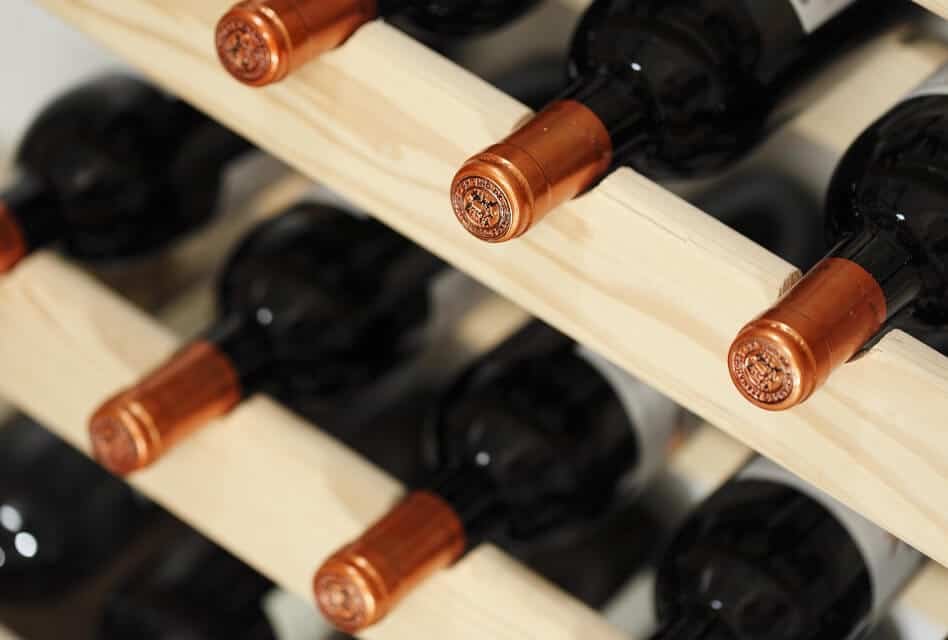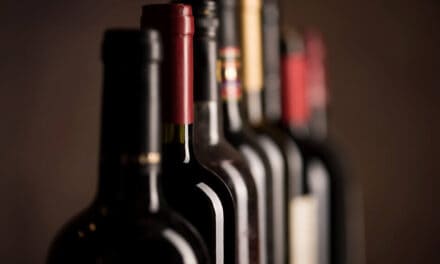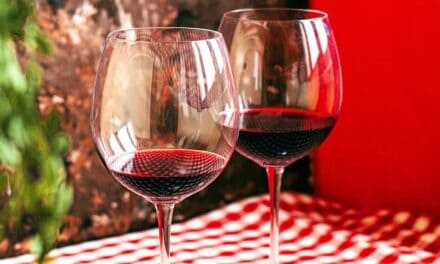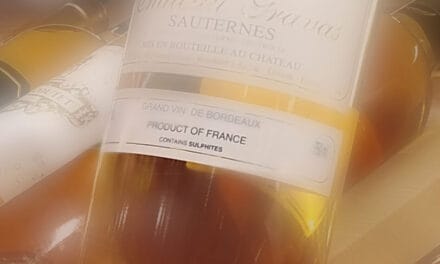Wine is not only one of the most complex beverages you can drink. It is also one of the most vulnerable. If you store it in the wrong place or in unsuitable conditions, chances are high that you will ruin it. Thus, you should make sure to provide the optimal conditions to store wine.
HOW TO STORE WINE PROPERLY
To store your wine properly, you should provide the perfect conditions:
- The Right Temperature
- Protection from Sunlight
- The Right Level of Humidity
- The Correct Storing Position
- Protection from Vibration
- Protection from Aggressive Smells
To understand all of these factors better, let us discuss them in detail.
The Right Temperature for Storing Wine
When you think about how to store wine, the first thing you should consider is temperature. High temperatures speed up your wine’s aging process. Its aromas volatilize and leave the wine unenjoyable. On the other hand, low temperature can cause its acids to crystallize and form sediments that sink to the bottom of the bottle. When drinking that wine, these sediments create an unpleasant sandy mouthfeel. Besides, the lack of acids can leave the wine out of balance.
Avoid temperatures above 68°F (20°C) or below 25°F (-4°C) for your wine storage by all means. The optimal storing temperature depends on the type of wine:
- full-bodied red wine: 63-64°F (17-19°C)
- light- & medium-bodied reds: 54-61°F (12-16°C)
- dry white wine: 46-54°F (8-12°C)
- sweet white wine & sparkling wine: 41-46°F (5-8°C)
If you store different wines in the same room, aim for a temperature of around 55°F (13°C).
In any case, a constant temperature is even more important than the right temperature. Rising temperatures cause the liquid in the bottle to expand, while temperature drops let it contract. If this process repeats frequently, the wine might push the cork out of the bottle and cause a leak.
To avoid temperature changes, choose the right room. A closet in the center of the house is better than a room with an exterior wall that is affected by weather changes.
Why You Should Protect Wine from Light
Another factor that affects the quality of wine during storage is light. Sunlight (or, more specifically, the ultraviolet rays of sunlight) starts chemical reactions. It causes the wine to spoil and develop unpleasant aromas. If your wine smells like cheese, you probably expose it to too much sunlight.
But UV rays also affect the wine’s color: White wines that are exposed to sunlight for a long time get a yellow tone. Red wines lose their color and become pale.
For these reasons, wine bottles typically are made of green or brown glass. For very vulnerable wines like old Madeira, vintners even choose black bottles. These bottles work like sunglasses and absorb at least some of the UV rays.
However, you should take additional measures to protect your bottles against sunlight. Always store wine in a dark place in the basement. Alternatively, leave the bottles in boxes or cover them with sheets.
By the way: Artificial light (from light bulbs) does only little harm to wine. But as it can fade the bottle labels, you should switch it off when you don’t need it. The best choice in terms of light is a room with LED lights but without windows.
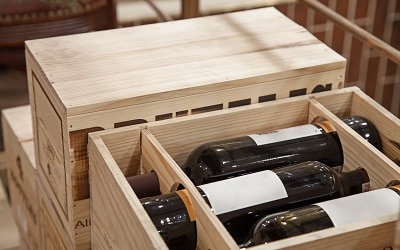
Wine Bottles in Wooden Boxes
The Right Level of Humidity for Storing Wine
The third factor that affects a wine’s quality is humidity. The right level of humidity is essential for bottles that are sealed with a cork.
If it is too low, the cork will dry out and become porous. A porous cork lets more oxygen into the bottle and causes it to spoil. Besides, small parts might break away from the dry cork and sink into the wine. If this happens, they will give the wine a very unpleasant, moldy taste.
In contrast, a very high level of humidity might promote mold. Mold is not dangerous for a properly sealed wine, but it can destroy its bottle label.
A humidity level of 60 to 70% is perfect for storing wine. But anything between 50 and 80% is safe as well. Unless you live in the desert, the arctic, or the rainforest, humidity probably won’t be a problem.
The Correct Storing Position for Wine
To protect the corks of your wine bottles, you have to take care of their position. If a bottle lays on its side, the liquid inside is in contact with the cork and keeps it moist. This prevents the cork from drying out and causing the negative effects mentioned earlier in this article. Thus, you should store corked bottles horizontally.
Bottles with a plastic cap or a screw top are an exception. You can also store them standing up. Their caps can’t dry out, so you don’t create a risk of ruining your wine.
Why Vibration Harms Wine
A factor that many wine lovers overlook when storing their bottles is vibration. Especially in old wines, regular moving or shaking can harm a wine’s aging process. It prevents the sediments from settling down and gives the wine an unpleasant gritty taste.
Thus, you should keep your wine away from your washing machine and dryer. Also, don’t store bottles on top of your refrigerator.
By the way, there is no need to worry about wine quality when traveling. If you expose a bottle to vibration only for a short period, for instance, in a car or a plane, it will recover from it, given that you put it in proper storage afterward. You can reduce the risk by using a proper transportation container, though.
How to Protect Your Wine from Smells
If you expose your wine to strong smells for weeks, they can affect it as well. The cork absorbs them and transmits them to the wine. Thus, don’t store wine bottles close to cleaning chemicals, heating oil, paint, or similar substances. There are even some types of fruit and vegetable that impose their aromas on wine when stored together.
Also, don’t store wine bottles in cardboard boxes for a long time. The boxes can acquire a mold smell over time that might be transmitted to the cork and finally to the wine.
Bottles with screw tops are immune to transmissions of smells. So you don’t need to bother about storing them next to other liquids or supplies.
HOW LONG CAN YOU STORE A CLOSED BOTTLE OF WINE?
Depending on the type, storing wine for a long time can damage it, even if you provide perfect conditions. The following list gives you an idea of how long you should store wine at the maximum before drinking it.
- You should drink light white, Rosé, and red wines when they are young and crisp. Don’t store these wines longer than a couple of weeks, especially when they come in a clear bottle and with synthetic corks.
- Many fruity reds and whites that are less complex have only little aging potential. These include affordable Chardonnay wines and white Bordeaux, Sauvignon Blanc, Pinot Gris, and light Beaujolais. Store them for 1 to 2 years maximum.
- High-quality red and white wines keep for 2 to 5 years and improve significantly during that time. German Rieslings, Pinot Noir, Merlot, Crus Bourgeois wines, and similar reds from France, Spain, and Portugal belong in this category.
- Only a few wines should be stored for more than 5 years. On the white side, this is true for the best Rieslings, white Burgundies, Chardonnay, Sauternes, and other high-quality late-harvest wines.
- On the red side, there are more proper candidates for long-term storage: Barolo, Barbaresco, Rioja Gran Reserva, Cabernet Sauvignon, and Burgundy wines are among them. Also, many fortified wines like Madeira or Port will last for decades.
HOW LONG CAN YOU STORE WINE ONCE OPEN?
Once open, wine is significantly more sensitive than a sealed bottle. The contact with air will start further oxidation and cause the wine to spoil. However, when handling it properly, you can store wine for up to one week after opening:
- Recork the wine. You can use a special mechanical device for this purpose or manually slide the cork back into the bottle. By placing wax paper around it, you can make this procedure easier and also keep the cork from falling apart while you put it back in.
- If the cork is broken, use a rubber wine stopper for resealing. These will keep oxygen out of the battle and prolong the wine’s life for a couple of days.
- The safest way is to use a vacuum pump to remove the air from the bottle and create an almost airtight seal. Alternatively, consider a more sophisticated wine preservation system.
THE PERFECT PLACE FOR STORING WINE: WINE COOLER
If you are a wine lover and want to provide the best conditions for your wines, consider buying a wine cooler. Wine coolers are special refrigerators that offer the perfect conditions for wine.
A regular refrigerator is not a proper place to store wine in the long term. It cools down food and drinks to 41-45°F (5-7°C). Low temperatures that low can mute delicate aromas. Thus, you shouldn not store wine too long there. Besides, household fridges tend to be very dry storages, and they vibrate constantly. As explained above, both dryness and vibrations can damage wines.
Wine coolers are designed to provide the optimal temperature and the right level of humidity for wine. Also, they do not vibrate. By storing wine in these special fridges, you also ensure that it does not suffer from the food smells in your regular fridge. Many wine refrigerators even allow you to set up two different cooling areas. These allow you to store different types of wine at the right temperatures.
Make sure to set up your wine fridge properly. Otherwise, you might damage it or cause it to sound an alarm.
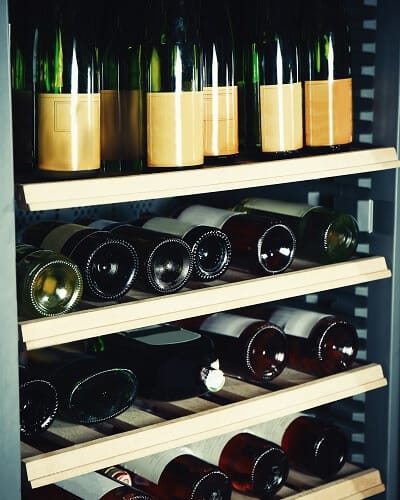
Wine Fridge
FINAL WORDS
Storing wine is an essential topic for every wine lover, but actually, it isn’t that hard. If you follow this guide’s simple tips on how to store wine, you will keep your bottles safe and enjoyable until you are ready to open them.

